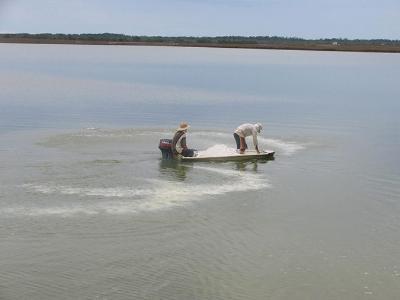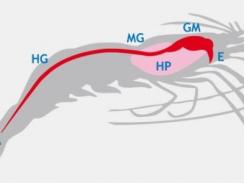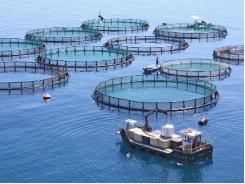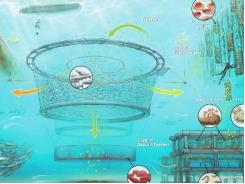Liming and its Principles in Aquaculture

The favorable influence of liming on fish/shrimp/prawn production in aquaculture ponds of soft and acid waters has been attributed to several of the effects on water quality. Liming increases the pH of bottom mud and thereby increases the availability of phosphorus added in fertilizer. Liming increases benthic production in fertilized ponds, apparently through increased nutrient availability and also liming increases microbial activity in mud through a favorable increase in pH.
The advantages of liming are:
- To kill most microorganisms, especially parasites, due to its caustic reaction.
- To raise the pH of acidic water to a neutral or slightly alkaline value.
- To increase the alkaline reserve in the water and mud which prevent extreme change in pH.
- To promote biological productivity, since it enhances the breakdown of organic substances by bacteria, creating increased oxygen and carbon reserves.
- To precipitate suspended or soluble organic materials.
- To decrease biological oxygen demand (BOD).
- To increase light penetration.
- To enhance nitrification due to the requirement of calcium by nitrifying organisms.
- To neutralize the harmful action of certain substances like sulfide and acid.
- To indirectly improve fine textured bottom soil in the presence of organic matter
Liming increases the alkalinity of water thereby increasing the availability of carbon dioxide for photosynthesis. Greater alkalinity after liming also buffers water against drastic pH changes common in eutrophic ponds with soft water.
Early morning pH will be higher after liming, but, because of buffering by bicarbonate, afternoon pH values will not be as high as before lime application. Liming raises the total hardness by adding alkaline earths (calcium and magnesium – PearlSpar-Aqua). By lime treatment, waters may be cleared of humic stains of vegetative origin, which restrict light penetration. The net effect of changes in water quality following liming is to increase phytoplankton productivity, which in turn, leads to increased fish/shrimp/prawn production.
Actually, total alkalinity is a more reliable indicator of the need for liming than total hardness because some ponds may have a low total hardness and a high alkalinity or vice versa. Total hardness is easier to measure, particularly in the field, than alkalinity.
Many times, the need for lime is first suggested when inorganic fertilization fails to produce an adequate plankton bloom. Nevertheless, total hardness or alkalinity analyses should be made and other possible reasons for the failure of the fertilizer to produce a plankton bloom determined before using lime
Types of Liming Material
A number of different substances are used as liming materials, the chemical used for the liming of soil and water are the oxides, hydroxides and silicates of calcium or magnesium, since these are the ones capable of reducing acidity. Typical liming substances include the following:
Calcium (CaCO3) and dolomite (calcium-magnesium carbonate) [CaMg(CO3)2]
The carbonates occur widely in nature. Among the common forms that can be utilized as liming substances are calcitic limestone, which is a pure calcium carbonate and dolomite limestone, which is a calcium-magnesium carbonate with varying proportions of calcium and magnesium. Commercial calcium carbonate is known as agricultural lime. The carbonates are the least reactive of the three liming substances. It is especially recommended to use dolomite [CaMg(CO3)2] during the culture period.
Calcium oxide (CaO)
This is the only compound to which the term lime may be correctly applied. Calcium oxide is variously known as unsulated lime, burnt lime and quick lime. It is manufactured by roasting calcitic limestone in a furnace. Calcium oxide is caustic and hygroscopic and it is often recommended to apply this lime to acidic soils only.
Calcium hydroxide (Ca(OH)2)
Calcium hydroxide is known as flaked lime, hydrated lime or builders lime. It is prepared by hydrating calcium oxide. All are grayish-white powders. Liming materials differ in their ability to neutralize acid. Pure CaCO3 is the standard against which other liming materials are measured. The neutralizing value of CaCO3 is 100 percent and those for pure samples of other materials are as follows: CaMg(CO3)2, 109 percent; Ca(OH)2, 136 percent; and CaO, 179 percent.
But dolomite (Neosparks’ PearlSpar-Aqua) is a good example for discussion. Carbon dioxide in water reacts with dolomite as follows:
CaMg(CO3)2 + H2O + CO2 <-> (Ca2+) + (Mg2+) + (2HCO3-) + (CO3 2-)
This reaction suggests that dolomite will compete with phytoplankton for CO2 and possibly reduce photosynthetic rates. In addition to removing all of the free CO2 initially in the water, the CaCO3 reacts with CO2 released from the decomposition of organic matter and with CO2, which diffuses into the water. The net result is that a few days after liming, equilibrium concentrations of CO2 are higher than before. This occurs because the dolomite traps CO2, which would have otherwise been lost to the atmosphere. Dolomite will contribute equivalent quantities of cations and anions so increases in total hardness and total alkalinity following liming will be equal.
One might conclude that the amount of dolomite necessary to raise the total hardness of a pond to a specified level could be directly calculated. Using such logic, the amount of dolomite needed to raise the total hardness of a 1-hectare x 1 –meter deep pond from 5 to 20 mg/liter would be 15 mg for each liter of water or 15 grams for each cubic meter. Since the pond contains 10,000 m3 , a total of 150 kg of dolomite would be required.
Lime serves two purposes – pH correction of water and pH correction of the soil bottom. When pH correction of water is the objective, lime can be made into slurry and either added to the incoming water or applied in front of aerators. If pH correction of pond bottom is the objective lime will need to be scattered like feed. Caution needs to be exercised while selecting lime. Most agricultural lime available in our country is granular not powder and has excessive quantities of moisture. It is strongly recommended that lime should be capable of passing 100 percent through a 60 mesh.
Since calcium is a major part of the bones and exuvia of fish and shrimp/prawn respectively requires high levels of calcium intake, especially after molting in shrimps/prawns. This requirement is met mainly by absorbing Ca available in seawater. The calcium content of the cuticle during the inter-moult stage is between 12% and 19% in shrimps and it loses about 23% of total body calcium by molting. However, the amount of minerals lost in the process of molting is higher than this because the exuvia includes other minerals in the form of calcium and magnesium salts.
Lime treatment:
1. To improve pond bottom condition during the preparation of grow-out pond. After each batch of cultivation, the bottom soil may become heavily polluted and acidic due to the accumulation of humus organic substances. Liming materials can be used to neutralize the organic acids released from humus substance and raise the pH value of bottom soil and to increase the degradation of organic substances, so that humus organic substances can be re-utilized as fertilizer during next cultivation
2. Liming materials also posses disinfecting property and therefore serve as disinfectants when applied in the preparation of grow-out pond.
3. During cultivation period, when pH of pond water drops below the normal range for culturing shrimp (below pH 7.2), liming materials can be used to raise the pH value to an optimal level. The dosage is based on the pH of bottom soil and the kind of liming material being used.
Neosparks’ Speciality Dolomite for Aquaculture - PearlSpar-Aqua
PearlSpar-Aqua reduces acidity of soil and water in Aquaculture ponds, stabilize the phytoplankton, minimizes fluctuations of pH by stabilizing alkalinity, thereby enhancing the growth and survival rate of shrimp, prawn and fish.
PearlSpar-Aqua contains Calcium Oxide, Magnesium Oxide, Silicon Dioxide, Aluminium Oxide in proper ratio along with Cobalt and Potassium.
Please visit for full details – PearlSpar-Aqua and GeoMix. (Water Quality Enhancing Formulations – Powders).
The importance of liming for water quality control in shrimp ponds
The usefulness of lime includes to reduce soil acidity and kill most organisms, especially parasites, during pond preparation and to reduce water pH during culture period. Generally, liming not only reduces the acidity of soil and water, which greatly affects the growth and survival rate of shrimp, but also stabilizes water pH and 4 promotes biological productivity. As water pH is one of the most critical chemical parameters for shrimp farming. The optimum water pH range in the shrimp pond is 7.4- 8.5. It is essential to stabilize the pH within this range. The pH value in the water is normally lowest in the early morning and highest in the afternoon. For the best water quality, the maximum diurnal pH fluctuation should not exceed 0.5. The main factor that affects the pH variation in the water is the alkalinity
Total alkalinity is defined as the total concentration of titrable bases in the water. Primary bases in the water are HCO3 - and CO3 - ions. Total alkalinity has been traditionally expresses as milligrams per liter (ppm) of equivalent calcium carbonate (CaCO3). Generally, the alkalinity varies from site to site. In the seawater, alkalinity is normally higher than 100 ppm, but in a freshwater area, alkalinity is often low, particularly during the rainy season. Low alkalinity in freshwater or in the low salinity area will affect the survival rate and molting of shrimp.
Lime can be used to reduce acidity in water. In case the water pH fluctuates greatly during the day, lime also can be used to increase the alkalinity in the water to stabilize water pH. In the area, where freshwater influence is more, particularly during the rainy season, water salinity as well as alkalinity decreases. When salinity becomes low and the alkalinity is lower than 50 ppm. The pH value also drops, resulting in moulting of shrimp being depressed and heavy mortalities occurring. CaMg(CO3)2 is applied every other day until the alkalinity value reaches 70-90 ppm. The pH will not fluctuate greatly, watercolour will improve and the shrimp will become normal.
On the other hand, in some areas the alkalinity is 90-100 ppm but watercolour and pH fluctuate greatly during the day. Lime should be applied every other day until the pH value becomes more stable and does not vary more than 0.5.
Since calcium is a major part of the exuvia, shrimps require high levels of calcium intake, especially after molting. This requirement is met mainly by absorbing Ca available in seawater. The calcium content of the cuticle during the inter-moult stage is between 12% and 19% in shrimps and it loses about 23% of total body calcium by molting. However, the amount of minerals lost in the process of molting is higher than this because the exuvia includes other minerals in the form of calcium and magnesium salts.
In addition, seawater has higher magnesium than calcium content, while in brackishwater calcium content is higher than that of magnesium. Magnesium is one of the most important elements for marine organisms. Its roles include the control of the nervous system or the functions of muscles and it is a major component of chlorophyll.
It can be observed after 2-3 months of culture that the phytoplankton in the pond water become very dense and the value of Magnesium in the water is reduced to some extent and may fall to zero. This will affect the growth, moulting and finally the survival rate of shrimp. However, the problem of low alkalinity and Mg content can be solved through the application of lime, particularly dolomite. Excessive liming, however, can be damaging because it decreases phosphorus availability through the precipitation of insoluble calcium or magnesium phosphate.
In practice, liming materials are not pure compounds and their neutralizing value must be determined by chemical analysis. Agricultural limestone is the liming material of choice for fishponds. If used in appreciable amounts, Ca(OH)2 or CaO may elevate the pH of water so high that fish may die. If fish are not present in ponds, Ca(OH)2 and CaO may be used as liming materials provided enough time elapses for the pH to decrease to tolerable level before fish are stocked.
Treatment with lime has several immediate undesirable effects on water quality. Most of the liming material does not dissolve at once and, as it settles through the water column, phosphate reacts with it and is lost from solution. The pH rises and appreciable free CO2 cannot occur in the water for photosynthesis. However, within a few weeks, the liming material reacts with mud to increase the mud pH and enhance the availability of phosphate fertilizer and with carbon dioxide to increase the alkalinity and the carbon dioxide reserve and hence primary production.
Method of Application. New ponds can best be limed before the initial filling. The lime requirement of soils from the bottoms of new ponds should be determined on a sample, which is representative of the pond bottom. The required amount of limestone is then spread evenly over the dry pond bottom. In older ponds, which contain water, best results are obtained by spreading the liming material over the entire pond surface.
Guidelines for liming during culture period.
| Status | Activities |
| 1. During the first month of culture when there is no water exchange and if the pH value is normal 7.5-7.8 in the morning | Dolomite should be done every 2-3 days at the rate of 150-200 kg/ha. |
| 2. The pH value is normal 7.5-8.0 in the morning and does not increase more than 0.5 in the afternoon, but there is blooming phytoplankton. | Using dolomite at the rate of 200-250 kg/ha every 2-3 days during the daytime. |
| 3. The pH value in the morning is lower than 7.5 | Using dolomite broadcast at the rate of 150 kg/ha/day then measure water pH the next morning; repeat the liming once a day until the pH value increase to 7.5 |
| 4. Water pH in the morning is about 8, but increases more than 0.5 in the afternoon (such as 8.8 or 9) and the watercolour is normal. | Using dolomite 200 kg/ha/day in the morning, repeat the application daily until pH during the day does not vary and water pH is not so high in the morning. |
| 5. Large sized shrimp 1 or 2 months before harvest. Water is a dark colour or during no water exchange, the water might have bubbles. Morning water pH value varies greatly during the day. | Using dolomite at the rate of 200 kg/ha/time at night or early morning. The frequency of liming depends on watercolour and water exchange. It is recommended that liming should be done every other day. However, it depends on the pond watercolour and pH. |
| 6. Prior to water exchange if not sure about water quality. | Broadcasting dolomite 200 kg/ha to prevent sudden change in water quality |
Related news
Tools

Phối trộn thức ăn chăn nuôi

Pha dung dịch thủy canh

Định mức cho tôm ăn

Phối trộn phân bón NPK

Xác định tỷ lệ tôm sống

Chuyển đổi đơn vị phân bón

Xác định công suất sục khí

Chuyển đổi đơn vị tôm

Tính diện tích nhà kính

Tính thể tích ao




 Aeration with pond capacity, Importance of Aeration and…
Aeration with pond capacity, Importance of Aeration and…  Aquaculture - disinfectants, sanitisers and feed supplements
Aquaculture - disinfectants, sanitisers and feed supplements